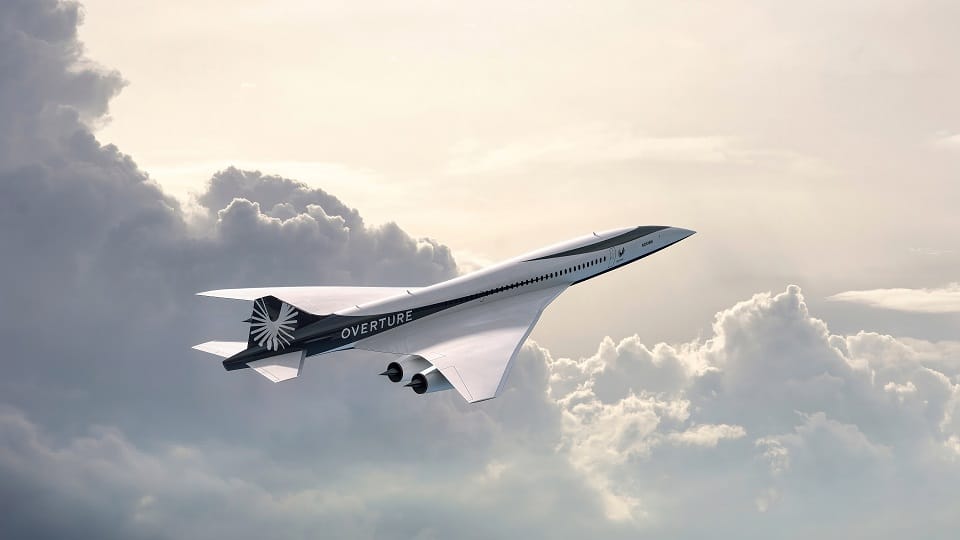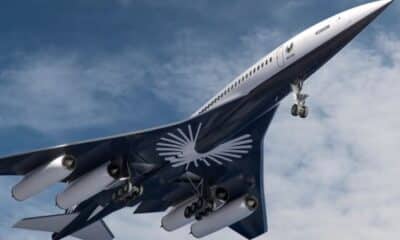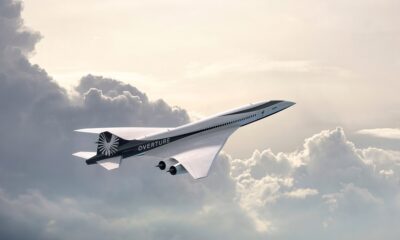Aerospace
This 65-seat Boom passenger jet travels at fighter jet speeds.
The passenger jet can travel at mach 1.7, which is comparable to the fighter jet’s speed. There was a period when Concorde Flight reinvented itself using cutting-edge aviation technology. #boom

The passenger jet can travel at mach 1.7, which is comparable to the fighter jet’s speed. There was a period when Concorde Flight reinvented itself using cutting-edge aviation technology. One of the most eagerly awaited aircraft manufacturers, Boom Supersonic, is set to deploy its first aircraft in 2029. The majority of the airlines who liked the idea have expressed interest in and agreed to purchase aircraft, including United Airlines as of right now.
Concorde supersonic flight (1976 – 2003)
The Concorde was a tailless aircraft with an ogival delta wing, a drooping nose for landing visibility, and a narrow fuselage that allows for seating for 92 to 128 passengers four abreast. Four Rolls-Royce/Snecma Olympus 593 turbojets with variable intake ramps and reheat for takeoff and supersonic speed acceleration power it. It was the first airliner to have analogue fly-by-wire flight controls, and it was made of aluminum. At an altitude of 60,000 feet, the aircraft could maintain a supercruise up to Mach 2.04 (2,167 km/h; 1,170 kn).
Overture supersonic flight (2029)
Today, the firm developing the fastest commercial airliner in the world unveiled Overture’s improved design and announced a new partnership with Northrop Grumman to create special mission variants of the aircraft.
This aircraft has an extraordinary range of about 4,250 nautical miles and can travel at a speed of Mach 1.7 while carrying up to 65–80 passengers and travelling at double the speed of existing aircraft. In addition, this aircraft can be run entirely on sustainable fuel (SAF).
The company showcased its development phases at the Farnborough airshow, including five wind tunnel tests, 26 million cores of simulated software design, and numerous other testings.
Silent features of Overture.
Four strong, wing-mounted engines will power Overture, allowing the aircraft to travel at Mach 1.7 over water and just under Mach 1 on land. The four-engine configuration significantly lowers expenses for airline operators while reducing noise.
Overture will feature the first automated noise reduction system ever used during takeoff. Without using afterburners, the airliner will fly while adhering to the same tight noise regulations as the most recent subsonic aircraft.
The fuselage of Overture has a bigger diameter at the front and a smaller diameter at the back. This method of design has been used by Boom to reduce drag and increase fuel efficiency at supersonic speeds.
The wings of the aircraft are shaped to improve handling in subsonic and transonic flight as well as supersonic performance.
The majority of Overture’s construction will be made of carbon composite materials, which are more thermally stable, stronger, and lighter than typical metal construction.
Overture Specifications:
- Cruise speed: Mach 1.7 supersonic, Mach 0.94 subsonic
- Range: 4,250nm with full payload
- Passengers: 65–80
- Exterior Dimensions: Length: 201 feet, Wingspan: 106 feet, Height: 36 feet
- Interior Dimensions: 79 feet long, up to 6.5 feet height at aisle
- Airframe: composite fuselage, wing, vertical, and horizontal
- Wing: gull with digital leading and trailing edge flap control
- Flight controls: 4x redundant digital fly-by-wire on 2 LRUs
- Powerplant: 4x medium-bypass 100% SAF-compatible turbofan
- Airport Community noise: ICAO Chapter 14 / FAA Stage 5

Aerospace
Which is bigger 777x or 787 aircraft ?

The 777X is a new series of the Boeing 777 family and is designed to be larger and more efficient than its predecessor. It features two variants: the 777-8 and the 777-9, being the larger of the two.
The Boeing 777X emerges as the larger sibling within the Boeing family, representing a significant leap forward in both size and efficiency. Comprising two variants, the 777-8 and the 777-9, the latter takes the crown as the larger of the two. With its expansive fuselage and impressive wingspan, the 777X is tailored for long-range journeys and boasts a substantial passenger capacity.
On the other hand, the Boeing 787, affectionately known as the Dreamliner, occupies a niche in the market as a smaller yet formidable aircraft designed for medium to long-range flights. Its distinguishing feature lies in its composite fuselage, a technological marvel that renders it lighter and more fuel-efficient compared to conventional aluminum counterparts. The Boeing 777X is larger than the Boeing 787 aircraft.
When it comes to passenger capacity, the 777-9 reigns supreme, typically accommodating a sizeable contingent of 400-425 passengers in its standard configuration. In contrast, the 787, with its more modest dimensions, typically carries between 240-290 passengers, depending on the variant and layout.
One of the remarkable innovations introduced with the 777X is its folding wingtips, a feature designed to address the logistical challenges of accommodating such a large aircraft in conventional airport gates. These folding wingtips enable the 777X to retract its wings, allowing it to fit into gates designed for smaller aircraft while still reaping the benefits of an extended wingspan during flight, thereby enhancing fuel efficiency and operational flexibility
Aerospace
China Secures Production Certificate for Mass Production of Pilotless eVTOL Aircraft

The first passenger-carrying pilotless electric vertical takeoff and landing (eVTOL) aircraft in the world, the EH216-S, has received the Production Certificate for its eVTOL aircraft from the Civil Aviation Administration of China (CAAC).
This is a significant milestone for EHang Holdings Limited, the leading UAM technology platform company in the world. This outstanding accomplishment is another big step towards mass manufacturing for the eVTOL aircraft and the ensuing commercial operations, building on the ground-breaking acquisition of the Type Certificate and the Standard Airworthiness Certificate for the EH216-S.
The PC is a crucial certificate that the aircraft maker receives from the CAAC, the country’s aviation authority. By obtaining this certificate, EHang has demonstrated that it has set up a quality management system for mass production that satisfies the airworthiness regulation standards set forth by the CAAC, and the company has been given permission to continue producing mass quantities.
It is also a strong guarantee of the calibre of the goods made by EHang. Raw materials, supplier management, manufacturing organisation, production quality control, aircraft pre-delivery test, after-sales repair and maintenance, etc. are all included in the mass production quality management system for the EH216-S.
To ensure that every aircraft and its components that roll off the production line strictly adhere to the approved type design and safety requirements, the system sets clear guidelines and documentation for every step in the production procedure. This ensures comprehensive traceability and safety control.
Aerospace
Four Airbus A380 Superjumbos lined up to be scrapped

In a strategic move aimed at reclaiming valuable resources from the iconic Airbus A380 aircraft, VAS Aero Services and Dr. Peters Group have announced a significant collaboration.
This partnership marks a milestone in aviation logistics and aftermarket services, with four of these colossal planes slated for teardown and redistribution of used serviceable material (USM).
The venture between VAS Aero Services, renowned for its expertise in aircraft dismantlement, and Dr. Peters Group, a prominent Germany-based investment fund management firm, underscores a commitment to sustainable aviation practices. This isn’t their first foray into scrapping A380s; their successful partnership has already seen the dismantlement of these aircraft, making them pioneers in this niche.
Under the agreement, the latest consignment brings the tally to eight A380s entrusted to VAS by Dr. Peters Group. Managing Director Christian Mailly of Dr. Peters Group emphasized the trust placed in VAS, citing their unparalleled capabilities in dismantlement and aftermarket sales network. It’s a strategic move in response to the growing demand for quality USM parts, particularly with the resurgence in reliance on the A380.
Notably, the teardown process will be carried out at various locations, optimizing the positioning of harvested parts to cater to different markets. While some parts will be positioned in Europe to support operators in the region and the Middle East, others will remain in the Asia-Pacific region. This meticulous strategy ensures efficient access to spare parts, benefiting MROs and airlines across these markets.
The decision to retire these A380s comes at a time when operators are reassessing fleet strategies amidst evolving market dynamics. Despite initial plans for quick retirement due to the emergence of more fuel-efficient alternatives, factors such as a rebound in long-haul demand and delays in new widebody deliveries have prompted operators to reconsider. The A380, with its unique capacity and capabilities, presents a practical solution for short-term capacity management.




























